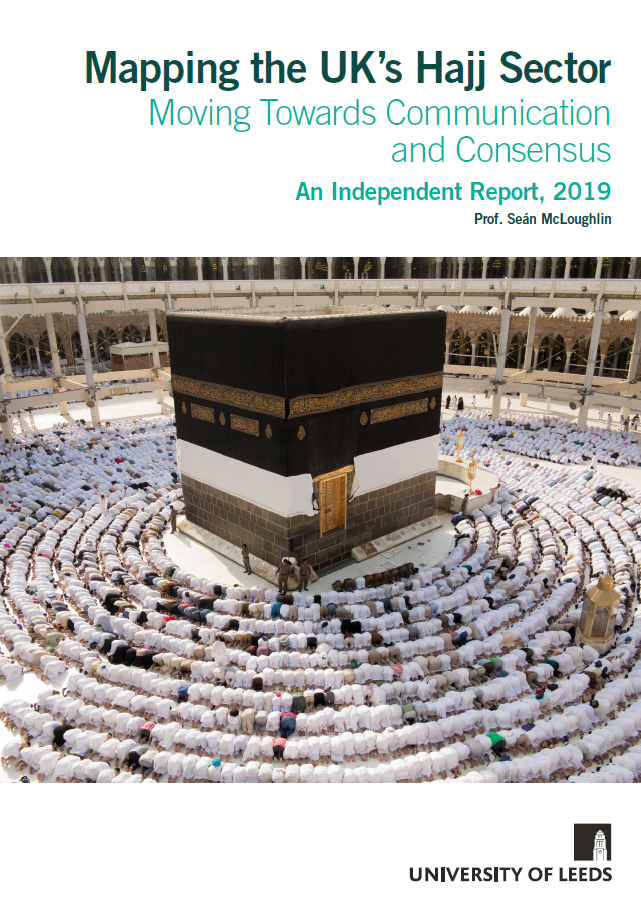
Author: Prof. Seán McLoughlin
Publisher: University of Leeds
Year: 2019
Format: downloadable pdf
Pages: 52
Source:https://hajj.leeds.ac.uk/wp-content/uploads/sites/69/2019/08/Mapping-the-UK-Hajj-Sector-Full-Report.pdf
The author notes, ” Until now, there has been no academic or policy-related research on the organisation of Hajj-going from the UK apart from my own preliminary work . . . This report is therefore the first evidence-based, independent mapping and analysis of the economic, social, cultural and political dynamics of the UK Hajj sector and the ways that the pilgrimage is organised transnationally across the settings of Britain and Saudi Arabia. The hope is that it will become a useful resource for stakeholders seeking to close the information gap and develop strategy in the UK and beyond. However, it does not directly address the related but separate dynamics of the UK Umrah sector.”
Some of Professor McLaughlin’s findings and observations
British Muslim Pilgrims and UK Hajj Markets: The number of British Muslim pilgrims has risen from 573 in 1969 to around 25-27,000 in recent years. This represents the joint highest number of pilgrims from the West (alongside France). About 100,000 British Muslims also travel annually for Umrah. Notably, Hajj pilgrims from Western countries are not restricted by the official quota of 1,000 pilgrims per million of total population in Muslim countries. So Muslims in the West benefit from opportunities to go for Hajj largely unavailable to Muslims worldwide. Western pilgrims are also often younger than elsewhere . . . it is unclear whether a growth in visas allocated to the UK during the last decade (about 10-15%) will keep pace with British Muslim population growth (around 30%).
Why is the Cost of UK Hajj Packages Rising?: A fuller breakdown of package costs would be useful for intending pilgrims but factors impacting the rising price of Hajj include: i) Brexit and the drop in the value of the pound; ii) simple “supply and demand” in terms of flights and accommodation as Muslims worldwide seek to be in Makkah for a minimum 1-2 key weeks in the year; iii) a new tax regime in Saudi Arabia from 2018; iv) a hike in the cost of Hajj-related services provided by very profitable Mutawwif companies, with an apparent discrepancy between what UK organisers and pilgrims pay as compared to those from Muslim countries such as Turkey or in South Asia; v) longstanding “Saudi-isation” of a workforce hitherto reliant on economic migrants, which has driven up labour costs. Of course, commercialization of the Hajj per se has also impacted what UK Munazzams consider normal margins and profits.
Pilgrimage and Tourism: in the 2000s, pilgrimage was still [Saudi Arabia’s] third largest industry. 58% of international tourist arrivals in Saudi Arabia were for Hajj or Umrah and 47% of international tourism expenditure in 2001 concerned Hajj or Umrah (Burns 2007: 229). Together with private capital investment partners, and boosted by rising oil prices, the Kingdom started to develop accommodation, retail and related services in Makkah, with a view to significantly increasing pilgrim (and especially ‘premium’ pilgrim) numbers. With fierce competition between multinationals for Makkah’s prime real estate, costs in every part of the industry were driven up. In 2011, the city’s Chamber of Commerce estimated that $10 billion had been spent by pilgrims during Hajj . . .
Vision 2030 and UK PLC: The publication in 2016 of Vision 2030, which is Saudi Arabia’s strategic plan for the future, represents a revolution in efforts towards modernisation in the Kingdom. With ongoing instability in the price of oil, pilgrimage remains central to the overall programme for economic and social change. However, it is now being linked even more clearly to a wider tourism agenda. A very ambitious target has been set to more than double current Hajj numbers to 6 million and grow Umrah numbers to 30 million by 2030. As an increasingly year-round, non-obligatory minor pilgrimage, Umrah takes just half a day to complete. Thus, pilgrims will be free to visit huge new tourist sites to be developed on the Red Sea coast, the ruins at Al-‘Ula or go shopping in Jeddah. US$50 billion of investment in infrastructure includes a new airport in Jeddah set to open in late 2019. A new Haramain High-Speed Railway linking Makkah-Jeddah-Airport-Madinah, which promises to slash travel times, opened in September 2018. Notably, its stations are designed by UK-based architectural design and engineering firm, Fosters and Partners, who have also been involved in the Jabal Omar development of luxury hotels with unobstructed views of Masjid al-Haram. . .
Accomodation:. . . There is also low supply and high demand for accommodation due to the demolition of older, cheaper hotels in Makkah that many UK organisers have made use of hitherto. The hotels being built near Masjid al-Haram are mostly 5*. International hotel chains have realised the value of the captive Hajj market and now lease 50% plus of these new hotels. The Clock Tower building above the Great Mosque in Makkah is 90% owned by Accor Hotels of France. International brands charge international prices. In the past there may have been more flexibility or discounts
Misleading advertising: . . . unsurprisingly, pilgrims cannot always easily understand the difference between a 5* package priced at £9,000 and one at £6,000. It takes time and effort too for the Hajj organiser to explain this. Furthermore it is widely acknowledged that a 5* hotel rating in Makkah and Madinah does not equate to a 5* rating in the UK or even the rest of Saudi Arabia. One argument is that some Munazzams’ accommodation agents in Saudi Arabia are unfamiliar with the UK and its standards and so some UK agents have taken advantage of these discrepancies in grading/descriptions, as well as making use of unrated apartments instead of hotels.
